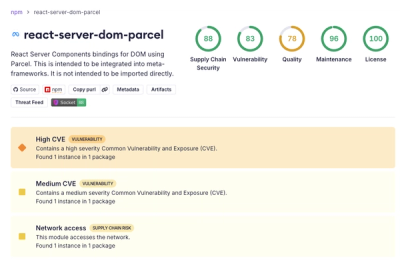
Security News
Deno 2.6 + Socket: Supply Chain Defense In Your CLI
Deno 2.6 introduces deno audit with a new --socket flag that plugs directly into Socket to bring supply chain security checks into the Deno CLI.
react-native-blurhash
Advanced tools
🖼 Blurhash is a compact representation of a placeholder for an image. This is a Native UI Module for React Native to asynchronously wrap the Blurhash implementations and make them usable in React Native. Also supports encoding!

🖼️ Give your users the loading experience they want.
Install via npm:
npm i react-native-blurhash
npx pod-install
BlurHash is a compact representation of a placeholder for an image. Instead of displaying boring grey little boxes while your image loads, show a blurred preview until the full image has been loaded.
The algorithm was created by woltapp/blurhash, which also includes an algorithm explanation.

This is how I use it in my project: Note: You can also use the react-native-blurhash encoder to encode straight from your React Native App! |

|
The <Blurhash> component has the following properties:
| Name | Type | Explanation | Required | Default Value |
|---|---|---|---|---|
blurhash | string | The blurhash string to use. Example: LGFFaXYk^6#M@-5c,1J5@[or[Q6. | ✅ | undefined |
decodeWidth | number | The width (resolution) to decode to. Higher values decrease performance, use 16 for large lists, otherwise you can increase it to 32.
See: performance | ❌ | 32 |
decodeHeight | number | The height (resolution) to decode to. Higher values decrease performance, use 16 for large lists, otherwise you can increase it to 32.
See: performance | ❌ | 32 |
decodePunch | number | Adjusts the contrast of the output image. Tweak it if you want a different look for your placeholders. | ❌ | 1.0 |
decodeAsync | boolean | Asynchronously decode the Blurhash on a background Thread instead of the UI-Thread.
See: Asynchronous Decoding | ❌ | false |
resizeMode | 'cover' | 'contain' | 'stretch' | 'center' | Sets the resize mode of the image. (no, 'repeat' is not supported.)
See: Image::resizeMode | ❌ | 'cover' |
onLoadStart | () => void | A callback to call when the Blurhash started to decode the given blurhash string. | ❌ | undefined |
onLoadEnd | () => void | A callback to call when the Blurhash successfully decoded the given blurhash string and rendered the image to the <Blurhash> view. | ❌ | undefined |
onLoadError | (message?: string) => void | A callback to call when the Blurhash failed to load. Use the message parameter to get the error message. | ❌ | undefined |
All View props | ViewProps | All properties from the React Native View. Use style.width and style.height for display-sizes. Also, style.borderRadius is natively supported on iOS. | ❌ | {} |
Example Usage:
import { Blurhash } from 'react-native-blurhash';
export default function App() {
return (
<Blurhash
blurhash="LGFFaXYk^6#M@-5c,1J5@[or[Q6."
style={{flex: 1}}
/>
);
}
See the example App for a full code example.
| iOS Screenshot | Android Screenshot |
|---|---|
 |  |
If your app is really colorful you might want to match some containers' colors to the content's context. To achieve this, use the getAverageColor function to get an RGB value which represents the average color of the given Blurhash:
const averageColor = Blurhash.getAverageColor('LGFFaXYk^6#M@-5c,1J5@[or[Q6.')
This library also includes a native Image encoder, so you can encode Images to blurhashes straight out of your React Native App!
const blurhash = await Blurhash.encode('https://blurha.sh/assets/images/img2.jpg', 4, 3)
Because encoding an Image is a pretty heavy task, this function is non-blocking and runs on a separate background Thread.
If you need to validate a blurhash string, you can use isValidBlurhash.
const result = Blurhash.isValidBlurhash('LGFFaXYk^6#M@-5c,1J5@[or[Q6.')
if (result.isValid) {
console.log(`Blurhash is valid!`)
} else {
console.log(`Blurhash is invalid! ${result.reason}`)
}
The performance of the decoders is really fast, which means you should be able to use them in collections quite easily. By increasing the decodeWidth and decodeHeight props, the time to decode also increases. I'd recommend values of 16 for large lists, and 32 otherwise. Play around with the values but keep in mind that you probably won't see a difference when increasing it to anything above 32.
Use decodeAsync={true} to decode the Blurhash on a separate background Thread instead of the main UI-Thread. This is useful when you are experiencing stutters because of the Blurhash's decoder - e.g.: in large Lists.
Threads are re-used (iOS: DispatchQueue, Android: kotlinx Coroutines).
A <Blurhash> component caches the rendered Blurhash (Image) as long as the blurhash, decodeWidth, decodeHeight and decodePunch properties stay the same. Because unmounting the <Blurhash> component clears the cache, re-mounting it will cause it to decode again.
Cosine operations get cached in memory to avoid expensive re-calculation (~24.576 cos(...) calls per 32x32 blurhash). Since this can affect memory usage, you can manually clear the cosine array cache by calling:
Blurhash.clearCosineCache()
Note: At the moment, cosine operations are only cached on Android. Calling
clearCosineCache()is a no-op on other platforms.
FAQs
🖼 Blurhash is a compact representation of a placeholder for an image. This is a Native UI Module for React Native to asynchronously wrap the Blurhash implementations and make them usable in React Native. Also supports encoding!
The npm package react-native-blurhash receives a total of 13,248 weekly downloads. As such, react-native-blurhash popularity was classified as popular.
We found that react-native-blurhash demonstrated a healthy version release cadence and project activity because the last version was released less than a year ago. It has 1 open source maintainer collaborating on the project.
Did you know?

Socket for GitHub automatically highlights issues in each pull request and monitors the health of all your open source dependencies. Discover the contents of your packages and block harmful activity before you install or update your dependencies.

Security News
Deno 2.6 introduces deno audit with a new --socket flag that plugs directly into Socket to bring supply chain security checks into the Deno CLI.

Security News
New DoS and source code exposure bugs in React Server Components and Next.js: what’s affected and how to update safely.

Security News
Socket CEO Feross Aboukhadijeh joins Software Engineering Daily to discuss modern software supply chain attacks and rising AI-driven security risks.